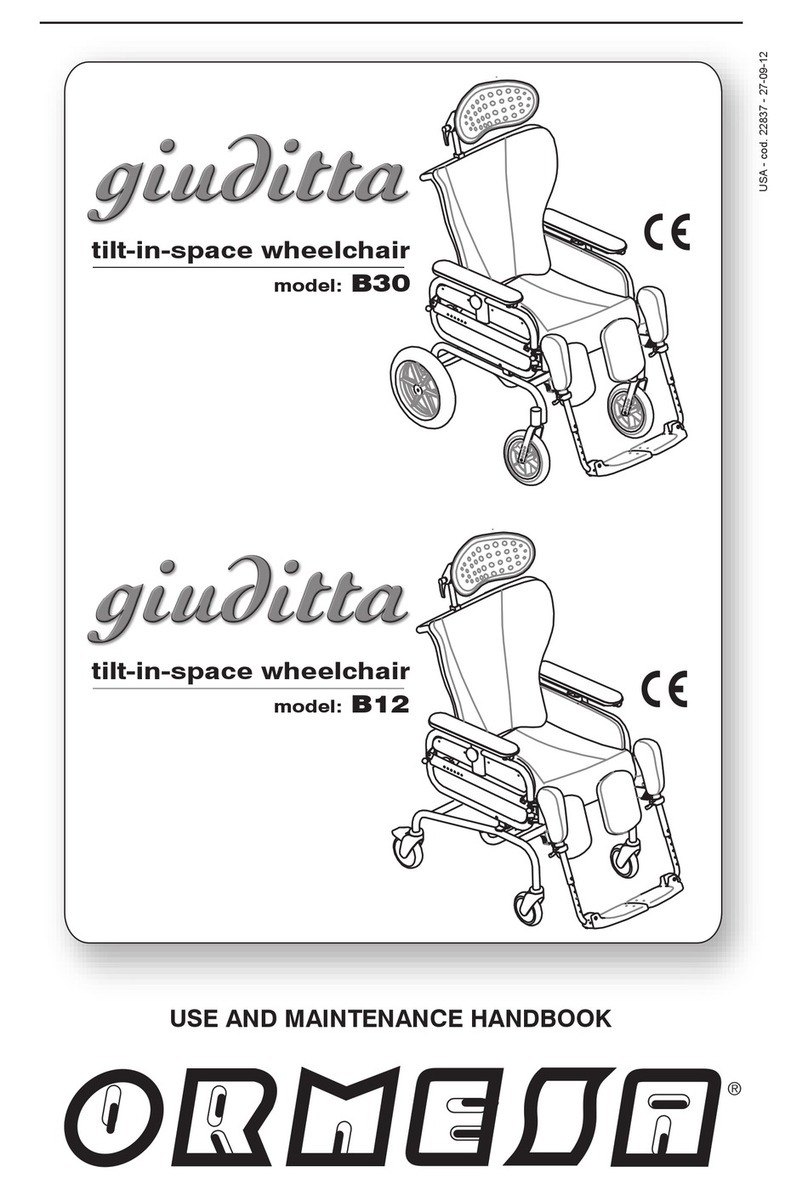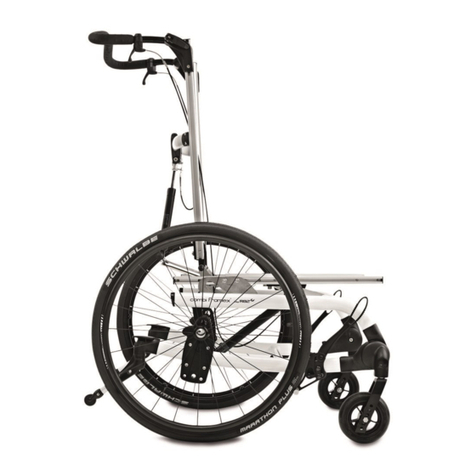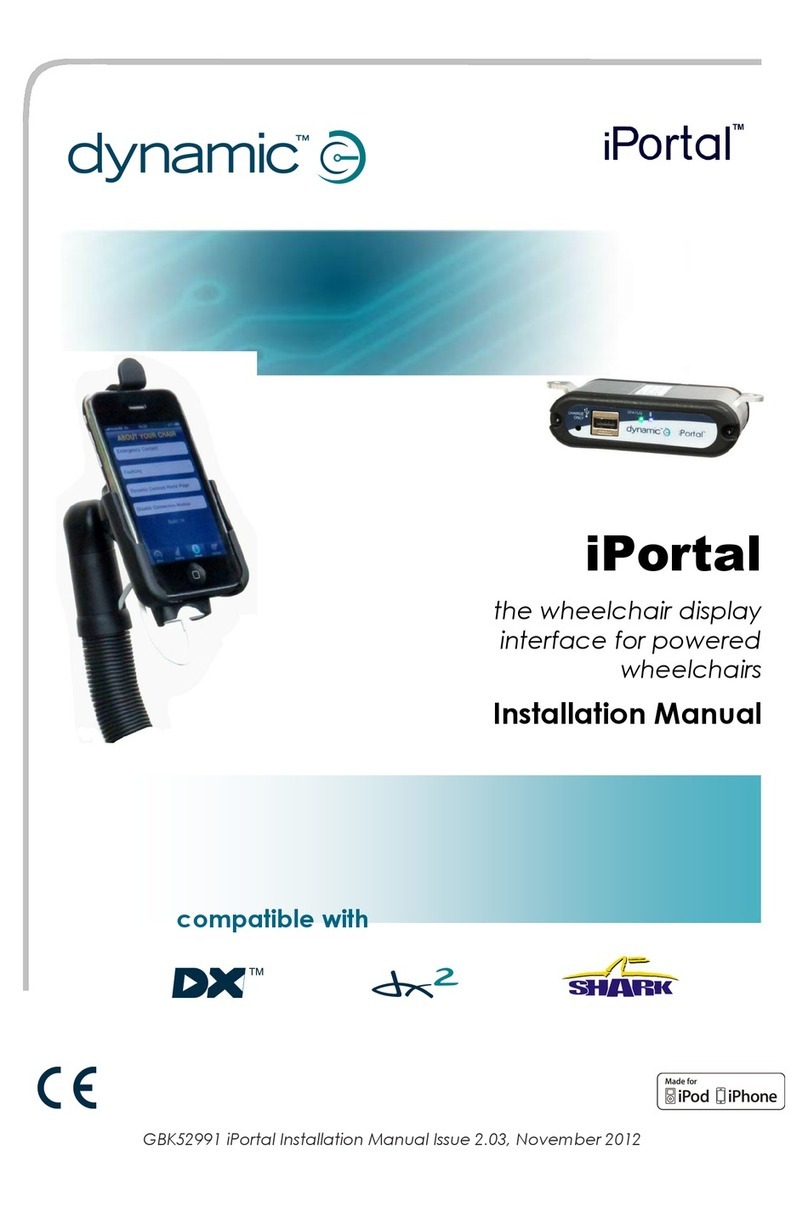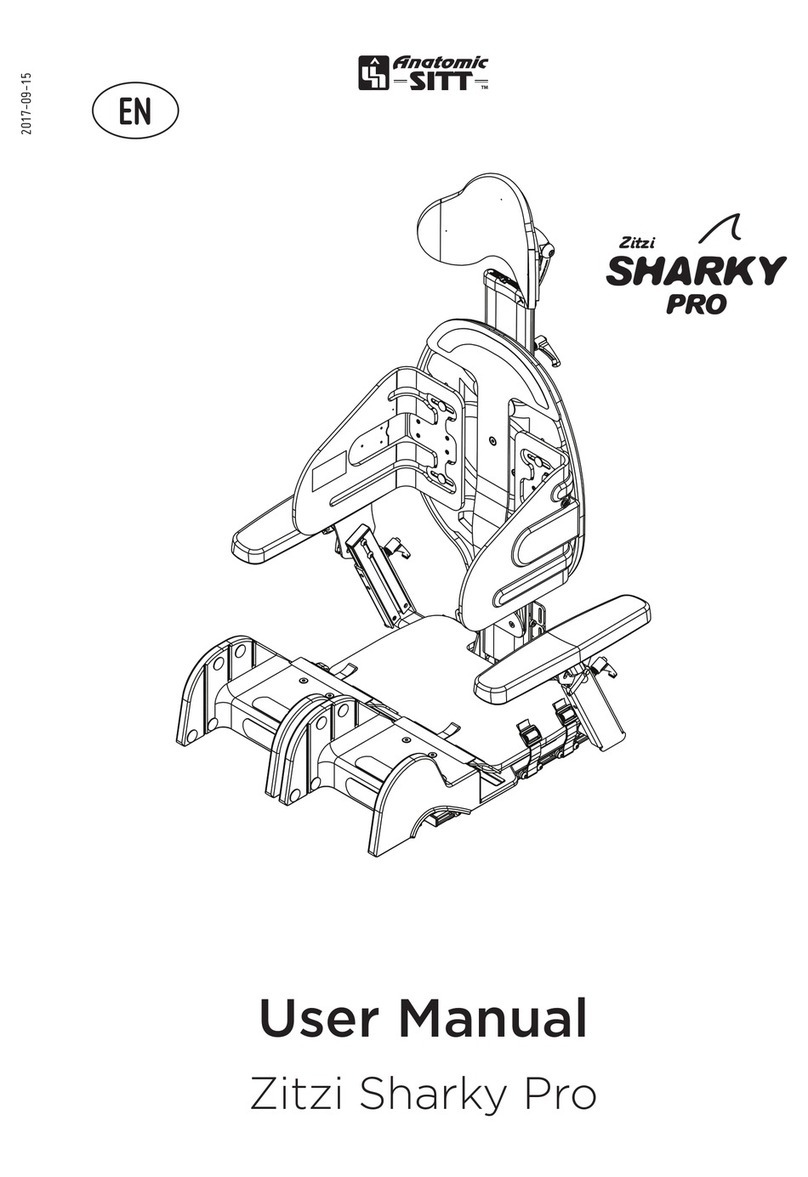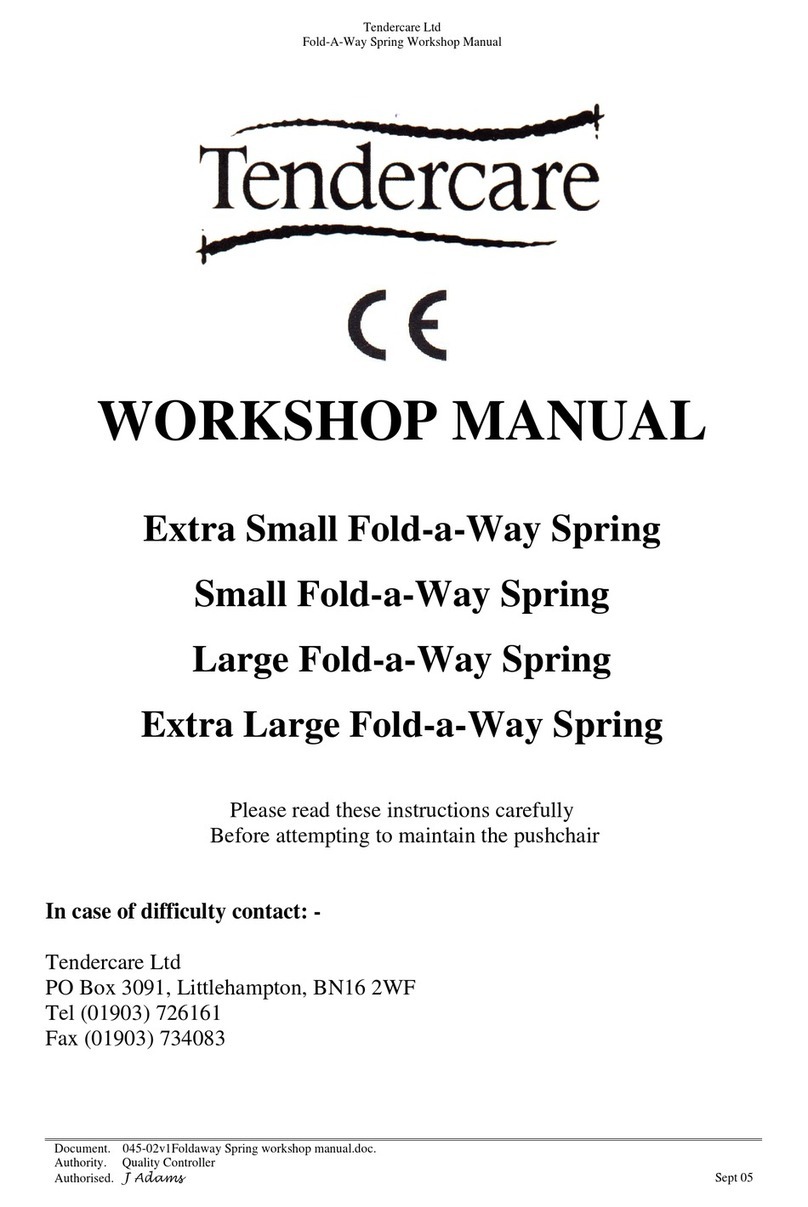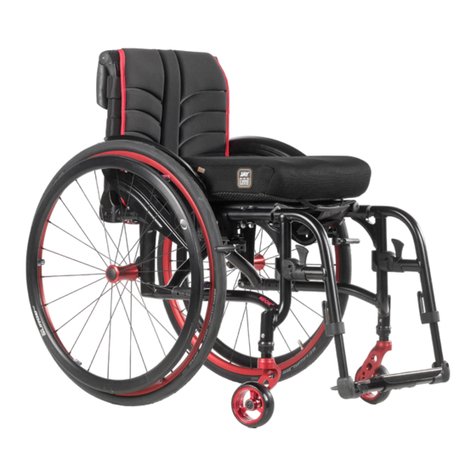Ormesa Juditta B30 Manual

tilt-in-space wheelchair
USE AND MAINTENANCE HANDBOOK
model B30
model B60
model B12
ING - cod. 220160 -


ORMESA thanks you for choosing JUDITTA wheelchair.
JUDITTA is attractive and easy to handle.
It represents attention to design combined with functionality, ergonomics and safety.
ORMESA s.r.l. recommends that you read this manual carefully to fully understand
its contents. In addition to help you become familiar with the device quickly, it also
contains practical tips for making the best use of it safely and keeping it in good working
order.
If, after reading it, you still have questions, contact your retailer, who will be happy to help you, or
call ORMESA directly at +39 0742 22927, send a fax to +39 0742 22637 or send an e-mail to:
info@ormesa.com
Luigi Menichini
1/86

TABLE OF CONTENTS
WARNINGS................................................................................................................................... 4
GUARANTEE ................................................................................................................................ 6
HOW TO STORE AND TRANSPORT THE MEDICAL DEVICE .................................................... 6
SOME EXAMPLES OF WHAT NOT TO DO WITH JUDITTA ........................................................ 7
HOW TO TILT THE WHEELCHAIR AND CLIMB UP PAVEMENTS............................................... 8
HOW TO FACE UP TO SLOPES IN GETTING ON AND OFF (B60 version) ................................. 11
HOW TO USE JUDITTA FOR TRANSPORT ON A MOVING VEHICLE (private cars, bus, etc..) 12
HOW TO FIX THE 891 TIEDOWN (4 RINGS) ON THE FRAME .................................................... 13
LABELS AND PLATES................................................................................................................. 16
CONFORMITY DECLARATION .................................................................................................... 17
ABOUT JUDITTA WHEELCHAIR. Intended use.......................................................................... 18
TECHNICAL FEATURES and MODELS....................................................................................... 19
INITIAL PREPARATION................................................................................................................ 23
ASSEMBLY ................................................................................................................................... 25
HOW TO FIX SELF-PROPELLING WHEELS (B60 version) .......................................................... 30
ACTIVATION of the ANTI-TIP DEVICE (B60 version) .................................................................... 31
USING JUDITTA WHEELCHAIR................................................................................................... 32
BRAKING THE WHEELCHAIR ( B30 MODEL with 30cm rear wheels) .......................................... 32
BRAKING THE WHEELCHAIR ( B12 MODELS with four 12cm wheels) ........................................ 33
BRAKING THE WHEELCHAIR ( B60 MODEL with 60cm rear wheels) .......................................... 33
ADJUSTING THE TILT OF THE BACKREST................................................................................. 34
ADJUSTING THE INCLINATION OF THE SEAT BOTTOM (TILT- IN- SPACE) ............................. 35
CLOSING THE FOOTRESTS ........................................................................................................ 36
ADJUSTING THE FOOTRESTS IN HEIGHT ................................................................................. 36
FLEX. EXTENSION ADJUSTMENT OF THE FOOTRESTS .......................................................... 37
TURNING THE LEGRESTS........................................................................................................... 38
REMOVING THE LEGRESTS..................................................................................................... 39
$'-867,1*7+(/(*5(67,1&/,1$7,21
2/86

TURNING THE CALF RESTS ........................................................................................................ 41
DEPTH ADJUSTMENT of the CALFRESTS................................................................................... 42
FLESSO-EXTENSION of the CALFRESTS.................................................................................... 42
ADJUSTING THE HEIGHT OF THE ARMRESTS .......................................................................... 43
OPENING THE SIDE SUPPORTS................................................................................................. 44
ADJUSTING THE HEADREST....................................................................................................... 45
ADJUSTING THE DEPTH OF THE SEAT ...................................................................................... 47
HEIGHT ADJUSTMENT OF THE BACKREST ............................................................................... 50
TILT ADJUSTMENT OF THE PUSH HANDLE .............................................................................. 51
REMOVING THE UPHOLSTERY FOR THE WASHING................................................................. 52
ASSEMBLING THE ACCESSORIES............................................................................................. 54
RECLINABLE TABLE 824-R .......................................................................................................... 54
ABDUCTION BLOCK 834 ............................................................................................................ 61
FOOTREST LOCK 914 ................................................................................................................. 62
CALF REST 916............................................................................................................................ 64
REMOVABLE FOOTPLATE COVER 892...................................................................................... 66
REMOVABLE TABLE COVER 896 ............................................................................................... 67
HEADREST REMOVABLE COVER 936 ........................................................................................ 68
891 TIEDOWN HOOKS (4 RINGS) ................................................................................................ 68
IV POLE 933 (B30 and B12 version) ............................................................................................. 69
SET OF HAND BRAKES 905 (B30 version) .................................................................................. 71
SET OF HAND BRAKES 905 (B60 version) .................................................................................. 75
932 ANTI-TIP UP DEVICE (B30 version) ...................................................................................... 80
CHEST STRAP 828 ..................................................................................................................... 83
MAINTENANCE, CLEANING AND DISINFECTION ...................................................................... 84
CUSTOMER SERVICE AND SPARE PARTS................................................................................ 85
CONDITIONS FOR DURABILITY, REUSE AND REASSIGNMENT TO A NEW USER................. 86
3/86

WARNINGS
-Carefully read the instructions in this manual before using the device; they will
help you use the product safely and keep it in good working order. It is an integral
part of the product and should be kept for future reference
-The manual is intended for technically qualified retailers, those who use the
product and those who assist them; it provides instructions for using the product
correctly and must be supplemented by adequate knowledge of the rehabilitation
program for which it has been prescribed
-The manual reflects the technical state of the product at the time it was sold.
ORMESA reserves the right to make any changes to the product or manual
suggested by experience, technical considerations or regulatory developments
without any obligation to update its previous production and relevant manual
-JUDITTA wheelchair may be only used by persons who have read the rules and
instructions in this manual
-The doctor must check that the use of JUDITTA wheelchair and its accessories
conforms to current laws, regulations and standards
-The wheelchair must be used by persons of the BODY SIZE AND WEIGHT
specified in the paragraph “TECHNICAL FEATURES” on pages 19, 20,21 and 22
-The wheelchair must be guided by persons of suitable height and weight to
control its movements
- Before each use, always check that the brakes are working, the wheels are not
excessively worn and that the headrest, back and footrest are locked
-When pausing, always lock both brakes, even on level ground
-Always lock the brakes before the user gets in or out of the wheelchair and
before making any adjustments!
-The upholstery is fireproof in conformity with the UNI 1021-1/2 standard.
Nevertheless, keep it away from cigarettes, matches, fireplaces and open flame in
general
-Keeping the cushion and patient clean will prevent bedsores
4/86

:
Perform and
following the instructions shown in the
"Maintenance" chapter on page 8and HAVE
THE DEVICE AT THE
to VERIFY that it is WORKING
PROPERLY and in GOOD CONDITION, otherwise
warranty will fail and marking will lapse
PRODUCT other than the regular
maintenance shown on page 8 of the manual
must be by a
in the maintenance of
mechanical aids for disables, otherwise warranty and
marking will be voided
Any in the product and the
ARE .
REFER ONLY TO ORMESA, otherwise warranty and
marking will be voided
In case of about the of the product
or to parts or components, you are urged
to and
in the maintenance of mechanical aids for disables,
or directly ORMESA.
5/86

GUARANTEE
ORMESA guarantees the product for 2 years ; in case of problems, contact the
retailer where you purchased it. Always ask for original spare parts, otherwise the
guarantee will decline
-ORMESA will not be liable for damage in the following cases:
-use by an unsuitable person;
-incorrect assembly of parts or accessories;
-unauthorized modifications or service;
-use of other than original replacement parts and parts subject to wear (upholstery, wheels,
etc);
-improper use (such as, transporting objects or loads larger or heavier than those shown in the
instruction handbook t);
-damage caused by incorrect use and lack of regular maintenance, as shown in the instruction
handbook ;
-exceptional events;
-failure to follow the instructions in this manual.
THE GUARANTEE DOES NOT COVER WEAR PARTS, which are subject to wear
and tear, such as the upholsteries and the wheels.
HOW TO STORE AND TRANSPORT THE MEDICAL DEVICE
THE DEVICE MUST BE STORED AND PACKED using Ormesa original
packaging materials, unless the guarantee will be voided
-Once unpacked, THE TRANSPORT OF THE DEVICE must be done by
ANCHORING ADEQUATELY it to the vehicle
-When travelling by plane, or in the car, DO NOT SUBJECT THE FOLDED
FRAME TO LOADS THAT, especially with road bumps, COULD DAMAGE ITS
STRUCTURE
THE DEVICE MUST BE PARKED / STORED IN CLOSED AND DRY PLACES
-THE OPERATING ENVIRONMENT HAS NO PARTICULAR INFLUENCE ON THE
DEVICEUNLESSITISUSEDINCORRECTLY,suchasbyleavingitparkedfora
long time in direct sunlight or exposed to bad weather such as rain, or in marine
environments,wheresaltcouldcorrodethepaintandslidingparts.INTHIS
CASE,WERECOMMENDCAREFULCLEANINGANDDRYINGTHEFRAME
FOLLOWING THE INSTRUCTIONS SHOWN IN THE “MAINTENANCE,
CLEANING AND DISINFECTION” CHAPTER ON PAGES AND THE
WARNINGS ON PAGE
6/86

SOME EXAMPLES OF WHAT NOT TO DO WITH JUDITTA
-DO NOT USE THE DEVICE WITH SUBJECTS OF LARGER DIMENSIONS OR
WEIGHT than shown on pages 20, 21 and 22
-DO NOT ALLOW CHILDREN TO USE THE DEVICE OR EVEN PLAY WITH IT
-DO NOT PLACE EXCESSIVELY HOT LIQUID CONTAINERS OR OBJECTS ON THE
TABLE SURFACE that could cause damage or burns if overturned
-DO NOT ALLOW ANYONE TO STAND ON THE FOOTREST OR THE BACK OF
THE WHEELCHAIR
- DO NOT USE THE WHEELCHAIR TO CARRY THE USER UP AND DOWN STAIRS:
the structure of the wheelchair was not designed for that purpose
-DO NOT LIFT THE WHEELCHAIR BY THE FRAME OF THE LEGREST OR THE
FOOTREST to climb over obstacles
-NEVER LEAVE THE USER UNATTENDED, ESPECIALLY ON THE BEACH OR
NEAR A RAVINE, SWIMMING POOL, SLOPE, OPEN FLAME OR STAIRS
-DO NOT CARRY THE USER OVER ROUGH OR STEEP SURFACES OR STAIRS
-NEVER LEAVE THE AID PARKED ON SLOPING GROUND
- DO NOT CLIMB CURBS OR STEPS WITH JUST THE SIDE WHEELS (front or
back) because it could tip over (see fig. on page 10)
When the SEAT is COMPLETELY TILTED BACKWARDS and the BACK is
COMPLETELY RECLINED, DO NOT CLIMB OVER OBSTACLES OR STEEP
SLOPES that, SINCE THEY COULD EXCEED 12°, COULD CAUSE THE
STROLLER TO TIP OVER (SEE FIG. PAGE 10)
-DO NOT USE JUDITTA WHEELCHAIR IN THE SHOWER: its steel structure is not
suitable for that purpose. Contact ORMESA S.r.l. or your retailer for a specific
painted aluminium aid made for that purpose
-DO NOT USE THE PRODUCT IF PARTS ARE MISSING OR DAMAGED. Always
insist on original replacement parts or the warranty will be void
In case of HYPERKINETIC patients, the Anti-tip up device, art. 932, is
recommended when JUDITTA B30 is used tilted and reclined. (see fig. on page
8
7/86

HOW TO TILT THE WHEELCHAIR AND CLIMB UP PAVEMENTS
VIEW FROM ABOVE
Turned off
anti-tip device
PEDAL TO CLIMB STEPS
FOR JUDITTA B30
VIEW FROM ABOVE
Turned off
anti-tip device
PEDAL TO CLIMB STEPS
FOR JUDITTA B60
8/86

CLIMB FACING FORWARD
WARNING!
TAKE THE BACKREST
AND NOT THE PUSH HANDLE
PEDAL TO CLIMB STEPS
FOR JUDITTA B30
PEDAL TO CLIMB STEPS
FOR JUDITTA B60
DESCEND FACING BACKWARD
Turned off anti-tip device
UDITTA B30
Turned off anti-tip device
JUDITTA B60
9/86

10/86

HOW TO FACE UP TO SLOPES IN GETTING ON AND OFF (B60 version)
Help is needed to get on and off ramps and slopes
The user can still get on a slight climb by himself, as JUDITTA B60 has an anti-tip
device.
UPHILL SLOPE
Anti-tip device
DOWNHILL SLOPE
11/86

HOW TO USE JUDITTA FOR TRANSPORT ON A MOVING VEHICLE
(private cars, bus, etc..)
JUDITTA WHEELCHAIR conforms to the ISO 7176-19 and ANSI RESNA WC/19 standard,
which defines the safety requirements for transport, facing in the direction of travel on
moving vehicles (private cars, buses, etc..) following these warnings:
-THE WHEELCHAIR-SEATED OCCUPANT MUST FACE THE FRONT OF THE VEHICLE (see
fig. 2, page 14). According to the ISO 7176-19 point 6.3.4, compliance with ISO 7176-19 does not
preclude using the wheelchair facing rearwards in large accessible vehicles equipped and
approved with rear-facing wheelchair passenger stations
-The User should weigh no more than 136 kilos because the CRASH TEST provided by the
ISO and ANSI/RESNA standards only refers to wheelchairs/pushchairs for users whose weight is
136 kilos or less
-THE VEHICLE MUST BE APPROVED FOR TRANPORTING ORTHOPAEDIC
WHEELCHAIRS/PUSHCHAIRS IN CONFORMITY WITH STANDARD ISO 7176-19 (see fig.2,
page 14)
-THE WHEELCHAIR MUST BE ANCHORED TO THE VEHICLE WITH THE BACKREST AND
THE LEGRESTS IN THE UPRIGHT POSITION using: 1) a four-point strap-type tie down
system that complies with ISO 10542-2 supplied with the vehicle (see fig.2, page 14) and 2)
our accessory 891 – SET OF 4 TIE-DOWN HOOKS (4 rings) (see fig. 1, page 13, fig.2 page 14
and fig.3 page 15)
−THE USER MUST WEAR BOTH A LAP BELT AND A DIAGONAL SHOULDER BELT ISO
7176-19 or ISO 10542- APPROVED (i.e. belts with a label of conformity to these ISO
standards). THE USE OF A LAP BELT BY ITSELF IS NOT RECOMMENDED. Postural belts,
such as model 828 are not type-approved for use as restraint systems and can only be
used in addition
WARNINGS!
ORMESA RECOMMENDS THE USE OF A COMPLETE ISO 10542-2 COMPLIANT “WTORS”
SYSTEM, which consists of restraint systems for both the wheelchair and its occupant
-Whenever the user is transferred on a seat of the vehicle, the unoccupied wheelchair
should be stored in a cargo area or secured in the vehicle during the travel
-In order to preserve their effectiveness, belt restraints should not be held away from the body
by wheelchair components or pats, such as the wheelchair armrests or wheels (see fig. 3 and
4, page 15)
-shoulder-belt restraints should fit over the shoulders (see fig. 3 page 15)
-belt restraints should be adjusted as tightly as possible, consistent with user comfort and belt
webbing should not be twisted when in use
-in order to reduce the potential of injury to vehicle occupants, during transport the tray and all
accessories should be removed and secured separately in the vehicle
THE WHEELCHAIR MUST BE INSPECTED BY THE MANUFACTURER OR ITS AUTHORIZED
RETAILER OR DISTRIBUTOR BEFORE REUSE FOLLOWING INVOLVEMENT IN ANY TYPE
OF VEHICLE COLLISION
ANY ALTERATION OR SUBSTITUTION OF THE 891 TIEDOWN HOOKS OR WHEELCHAIR
PARTS OR COMPONENTS, WITHOUT THE WRITTEN AUTHORIZATION OF ORMESA SRL,
IS FORBIDDEN AND WILL VOID THE “ ” MARK AND THE WARRANTY
12/86

1)
WARNINGS:
-Suitable for ISO 10542-approved four-point straps provided in the vehicle. To anchor the
wheelchair to the transport vehicle see the instructions on page 14
-The User has to wear both a lap belt and a diagonal shoulder belt ISO 7176-19- or ISO
10542-approved (i.e. belts with a label of conformity to these ISO standards). Postural belts
such as model 828 are not approved for use as restraint systems and can be only used in addition
-The vehicle must be suitable for transporting orthopedic wheelchairs and pushchairs in
conformity with current laws
-Read the notices and instructions provided on page 4 of this use and maintenance manual.
REAR VIEW
WRENCH
WRENCH
WRENCH
WRENCH
SCREW
SCREW
NUT
ANTERIOR
891 TIEDOWN HOOK
POSTERIOR
891 TIEDOWN HOOK
HOW TO FIX THE 891 TIEDOWN (4 RINGS) ON THE FRAME
only for B30 and B60 version
The 891 tiedown hooks are safety devices and, as such, they must be fixed to the 869 frame
by skilled personnel, such as the manufacturer or reseller that supplied the stroller
UNSCREW THE INDICATED
SCREWS AND NUTS AND USE
THEM TO ASSEMBLE THE 891
FRONT SET OF 4 TIE DOWN HOOKS
CRASH TESTED
ISO 7176-19 e ANSI RESNA WC/19
13/86

2) HOW THE WHEELCHAIR IS TO BE SECURED IN A VEHICLE (private
cars, bus, etc..)
HOOK THE APPROVED 4-POINT BELTS OF THE VEHCLE TO THE 891 4 TIEDOWN
HOOKS (4 RINGS) AS SHOWN IN THE FIGURE AND IN THE DIRECTION OF TRAVEL OF
THE VEHICLE
DIRECTION OF TRAVEL
OF THE VEHICLE
BELTS AND HOOKS
OF THE VEHICLE
BELT HOOK COMPATIBLE
WITH 891 TIEDOWN HOKS
891 TIEDOWN HOOKS
891 TIEDOWN HOOKS
14/86

3) CORRECT POSITIONING OF THE OCCUPANT BELT RESTRAINTS ON
THE USER
ATTENTION! The pelvic belt restraint should be worn low across the front of the pelvis, so that
the angle of the pelvic belt restraint is within the preferred zone of 30° to 75° to the horizontal
(see fig. 3). A steeper (greater) angle within the preferred zone is desirable
ATTENTION! Postural belts such as 828 are not intended to be as an occupant restraint
in a moving,but they can be used in addition
YES
beneath
the armrest
and the
frame
FRONT VIEW SIDE VIEW
NO
above
the armres
and the
frame
THE INCORRECT PLACEMENT OF BELT RESTRAINTS
FRONT VIEW SIDE VIEW
15/86

LABELS AND PLATES
Series number Article number
Max load
Date of
production Warning! Read the
useand maintenance
handbook before use
Conformity with the
European safety
standards
LOT code
Name of the model
SECUREMENT POINT TO FOR THE ANCHORAGE OF THE ISO 10542-
2 APPROVED 4-POINT STRAP-TYPE TIEDOWNS SUPPLIED BY
THOSE VEHICLES WHICH ARE SUITABLE FOR TRANSPORTING
ORTHOPEDIC WHEELCHAIRS IN COMPLIANCE WITH THE ISO 7176-
19 STANDARD
1
212
®
s.r.l.
Via A. Da Sangallo, 1 06034 Foligno (PG) ITALY Tel. +39 074222927 Fax +39 074222637
M O D E L . P A R T N °
S N
LOT MAX. KG
!
16/86

CONFORMITY DECLARATION
ORMESA S.r.l. GUARANTEES AND DECLARES, under its own exclusive
responsibility, that the following Medical Device, technical aid for rehabilitation:
which this declaration refers to, conforms with the general requirements provided in the
medical devices Directive 93/42/EEC and subsequent amendments and additions,
according to which this device is class 1 and has been designed in observance of the
following standards:
CEI EN ISO 14971:2012 Medical Devices - Application of risk management to
medical devices
UNI EN 12183:2014 Manual Wheelchairs - Requirements and Test Methods
EN 12182:2012 Technical aids for disabled persons - general requirements
and test methods
EN 980:2004 Graphical symbols for use in the labelling of medical
devices
ISO 9999:2011 Technical aids for persons with disabilities - classification
and terminology
EN 1041:2013 Information supplied by the manufacture with medical
devices
ISO 7176-1:2014 Wheelchairs - Part 1: determination of static stability
ISO 7176-3:2012 Wheelchairs - Part 3: Determination of effectiveness of
brakes
ISO 7176-5: 2008 Wheelchairs - Part 5: Determination of dimensions, mass
and manoeuvring space
ISO 7176-7: 1998 Wheelchairs - Part 7: Measurement of seating and wheel
dimensions
ISO 7176-8: 2014 Wheelchairs - Part 8: Requirements and test methods for
static, impact and fatigue strengths
ISO 7176-11:2012 Wheelchairs - Part 11: Test dummies
ISO 7176-15:1996 Wheelchairs - Part 15: Requirements for information
disclosure, documentation and labelling
ISO 7176-22:2014 Wheelchairs – Part 22: Set-up Procedure
ISO 7176-19: 2008 Wheelchairs – Part 19: Wheeled mobility devices for use
as seats in motor vehicles, only for B30 – B60 versions
WC 19: Wheelchair
ANSI/RESNA
WC:4 2012 –Section 19 Wheelchairs Used as Seats in Motor Vehicles, only for B30
– B60 versions
January 7th, 2016 The Legal Representative
Luigi Menichini
17/86

ABOUT JUDITTA WHEELCHAIR. Intended use
JUDITTA wheelchair was designed based on more than twenty-five years of experience
with the elderly and disabled and is intended for hospital and home use. It may be
used outside if the warnings and instructions of this manual are observed, especially the
paragraphs “Warnings” on page 4 and 5, “Some examples of what not to do
with JUDITTA” on page 7 and “Maintenance, Cleaning and Disinfection” on pages
DQG.
The aid is intended for those adults who do not have control of their trunk and/or
that tend to slide on one side or to sit on their coccyx rather than on their gluteus
and allows convalescents, disabled, elderly, etc. TO REMAIN IN IT FOR EXTENDED
PERIODS LYING DOWN AS AN ALTERNATIVE TO STAYING IN BED.
The conformation and reclining of the backrest, the seat tilting and the reclining of
the leg rests allow the user to be positioned lying down, semi-lying down or
seated, while maintaining constant trunk-pelvis containment.
THE INCLINATION OF THE SEAT, THE CONFORMATION OF THE
BACKREST (TRIANGULAR) AND THE LOAD-BEARING PADDING
PREVENT SLIDING FORWARD AND FAVOUR TRANSPIRATION. THIS
ARRANGEMENT ALLOWS THE TRUNK TO REST ON SEVERAL POINTS,
predominantly lateral with respect to the spinal column.
THE TRUNK IS KEPT PERPENDICULAR TO THE PELVIS without particular
mechanical lateral supports or containment belts.
The NARROW BASE allows easy access to lifts or small rooms
The HEADREST completes the user's posture.
18/86
This manual suits for next models
2
Table of contents
Other Ormesa Wheelchair manuals
Popular Wheelchair manuals by other brands

Invacare
Invacare REA Dahlia 30 Service manual

Pressalit
Pressalit PLUS shower seat 450 Operation and maintenance manual
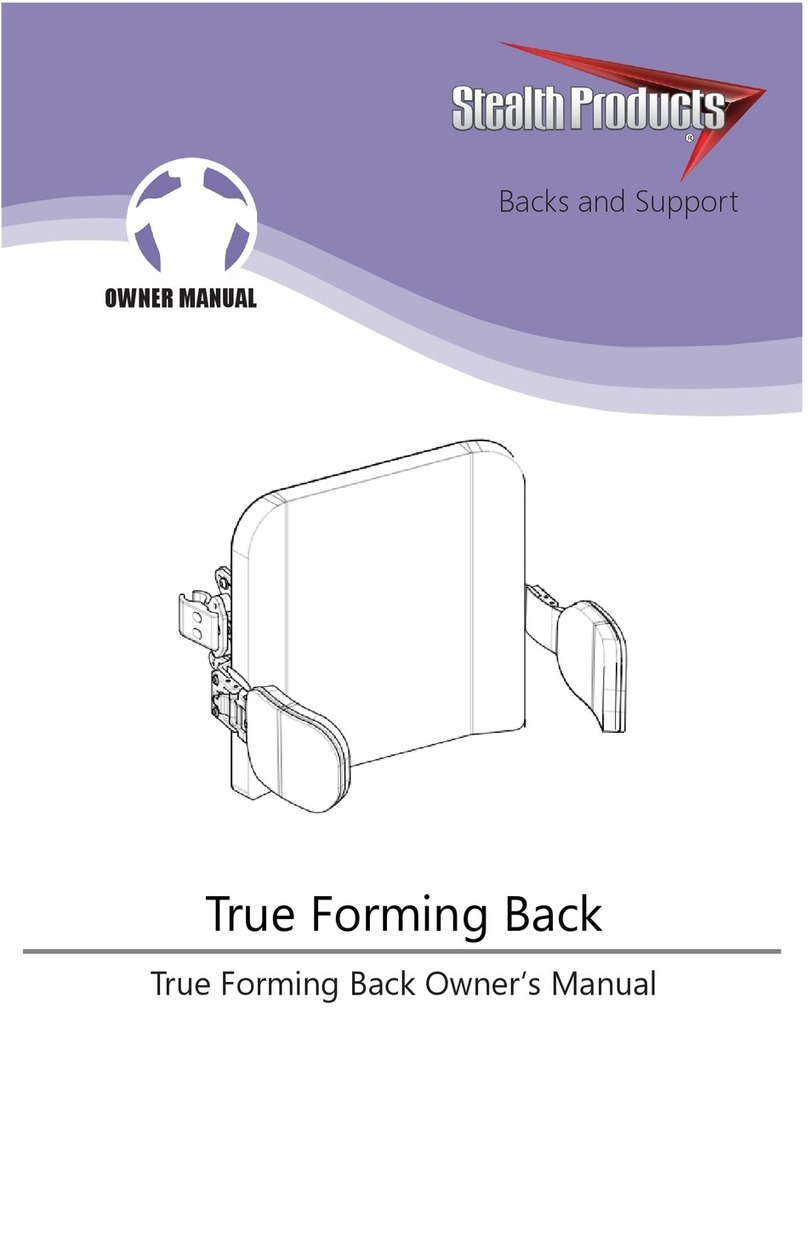
Stealth Products
Stealth Products True Forming Back owner's manual

NewLive
NewLive Magix owner's manual

AMG Medical
AMG Medical MedPro DEFENSE Zorbi 770-305 Assembly instructions
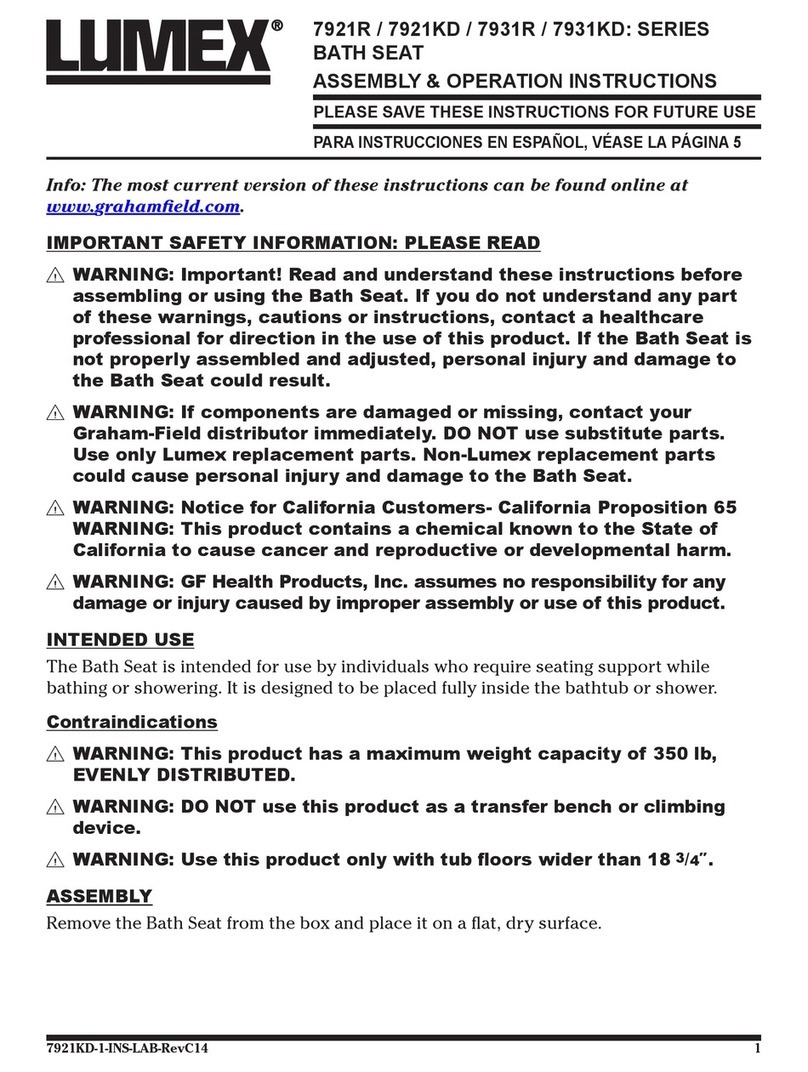
Lumex
Lumex 7921R Series Assembly & operation instructions
